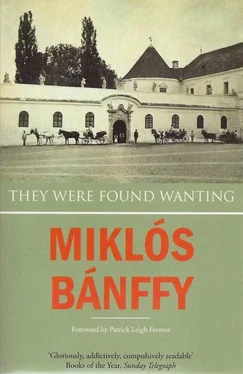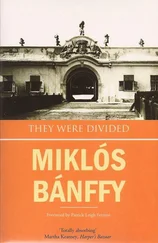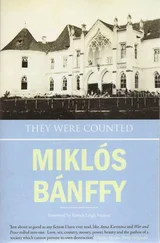Directly beneath him was the place reserved for the Abady family. Here the benches were also of scrubbed white pine but the book-rest was covered in the same light-green velvet as were the cushions of the pulpit. A Book of Psalms and a Bible were always placed on this rest. Directly behind it sat Balint and his mother. Here the benches formed, with the altar-table, an almost perfect square, the men in front and the girls at one side. The altar was covered with an embroidered cloth, as it always was for the Sunday services, but today, as it was the Feast of the New Bread and there was going to be Holy Communion, it carried also the silver vessels of the Denestornya church plate bearing the bread and wine, and these in their turn were covered by an ancient altar cloth of faded brocade, though the shape of the objects beneath could clearly be distinguished.

The first psalm had come to an end and the organ was playing softly. The girls, who until now had clustered together at the entrance to the church, tiptoed forward in single file, hurrying and jostling each other until they had found their places and could kneel for a few moments in prayer. Then they sat up, silently sniffing at the fine lawn handkerchiefs or bunches of rosemary they held in their hands. This was exactly as it always happened for it was an unwritten law that the men of the village should take their places first, followed by the important tradespeople and the village elders. Then came the women and boys who went to their seats in the choir beneath the organ and only when all the others were in their places could the unmarried girls take their places too.
Now the organ boomed out a hymn-tune. The priest intoned and then the whole congregation rose and sang together. Balint at once noticed how rough some of the voices seemed, even to the point of singing wildly out of tune — but there was no mistaking the deep faith and the eagerness and the sincerity with which they sang. It must have been like this with the early Christians when the Message was still new.

After the prayers the vicar read the passage from the Bible that was to be the text on which he based his sermon.
He was an old man with an old man’s quavering voice and he lingered long over the first syllable of each word. Everything he said Balint had heard before, and the rest of the congregation many times more than he; but it was all for the best, for the simple folk of the village understood it better than if they were hearing something new and so took it more to heart. And the text too was familiar because it was always the same. It was the Parable of the Sower and the Seed, and the sermon itself dealt with the seed which fell on good ground and brought forth fruit an hundredfold.
The sun’s rays lit up the interior of the church, catching here some small particles of dust which seemed to dance lightly in the still air, and there the bright colours in a girl’s head-scarf, the silver in the greying hair of one elderly villager or the flaming copper-coloured cheek-bones of another. The sparkle in the air was almost vaporous, so much so that the fine white of the church walls might have been covered with a layer of fine cream.
In some places, where the annual whitewashing — that ritual to ensure that the church interior was always immaculate — had been repeated for several hundred years, the lime wash was sometimes nearly three fingers deep and smoothed and softened every hard edge or angle of the vaulting, the groins and the projecting capitals of the columns.
To Balint the old church had never seemed so beautiful.
He looked around, as he had so many times before. On one side the three arches which began where the organ had been placed high up on a stone balcony were supported firmly by columns of Byzantine solidity. On the other, high above the girls’ benches, the last arch was joined to the stone balustrade which guarded the door of the Tabernacle and the Porta Triumphalis. Opening behind the pulpit these doors dated from the time when the church, then of course the home of Catholic rites, had been built in the twelfth century. Naturally no papers still existed to prove the age of the building, but its origins were nonetheless unmistakable.
This was one of the early churches constructed with two rather than three aisles. One, the most important, was the nave in the style typical of the times of Bela III and unique to Hungary. Here, in the apse and the transept, the columns and arches all dated from the original construction. The rest of the church had seen many changes. A good part had been burnt at the time of the Tartar invasions when much of the building had been destroyed — except for the dressed stone exterior walls — and had had to be rebuilt; and this was why the old main entrance on the west side was walled up while another door had been opened beside it. The pew door was surrounded with gothic arches similar to those in the rebuilt nave.
Later came the Reformation when, because the sermon was the most important part of the Reformed service of prayers, the pulpit became the principal feature of the church interior. So as not to obscure the altar this was place at the side, just where the transept began. Its elaborate carved stone decoration was in High Renaissance style.
Soon taste changed again and so the new baldachino and the organ casing were carved in flamboyant rococo.
So the little church, like the great castle on which it was dependent, grew and changed, and was transformed from its simple beginnings into a model of eclectic development whose diverse features, though organic parts of the whole, reflected the needs and desires and tastes of successive centuries.
Here too everything tended to extol the glory of the Abady family. What came first to view was the inscription round the pulpit: Erected to the glorious memory of the most noble and powerful lord GyorgyAbady StatuumPraes,anno1690. On the baldachino and again on the sounding board above the pulpit the Abady arms were prominently emblazoned, with the date 1740; while the monogram of that Count Denes Abady who became Chancellor of Transylvania and Master of the Horse to the sovereign was carved in high relief surrounded by garlands of leaves and flowers. Along the walls, all in similar narrow gilt frames, were all the printed announcements of the births, deaths and marriages of Abadys down the centuries, those of the women crowned with a double coat of arms — their own and their husbands’ — while those of male Abadys carried only the heraldic device of their own family, a golden gryphon with spread wings on a red ground, that device which in medieval times had been borne by the Abadys’ first ancestors, the Tomai chieftains. Under each announcement were written their titles and the distinguished posts they had occupied.
Just in front of the family bench were hung, one above the other, the notices of Balint’s father and grandfather.
Once again, as he always did each time he was there, he read the fading print and was carried back in memory to the days of his childhood.

The first memories, those which included both his father and mother as well as his grandfather, Count Peter, were hazy enough for he had been barely eight years old when his father had died so suddenly. The image of Count Peter, on the other hand, was much more vivid. He could remember the old man sitting beside him, in the place of honour where his mother now sat so placidly, her little chubby hand resting on the Book of Psalms in front of her. Count Abady’s fine profile and always closely shaven face, his wavy silver hair, even that scent of tobacco and lavender soap that seemed his special attribute and which the child had always associated with his grandfather’s presence, still seemed so real to Balint that he imagined that if he turned his head, the old man would still be there.
Читать дальше













